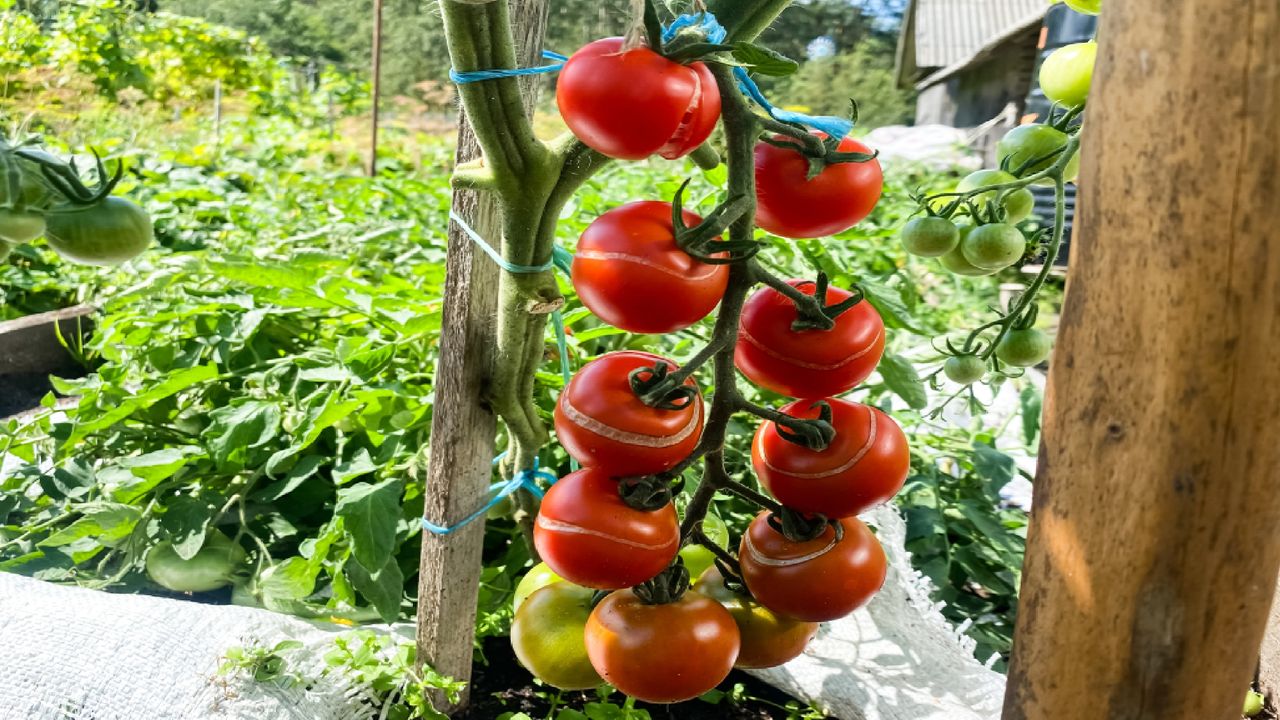Lifestyle
Save Your Split Tomatoes: Expert Tips for Gardeners

Tomato growers often face the frustrating challenge of split tomatoes, which can develop unsightly cracks just as the fruit reaches peak ripeness. While split tomatoes may seem ruined, they are usually still safe to eat if addressed promptly. Understanding the causes of splitting and implementing preventative measures can help gardeners salvage their harvests.
Understanding the Causes of Tomato Splitting
Most gardeners mistakenly believe that tomatoes split due to overripeness. In reality, the primary cause of splitting is inconsistent watering. When soil undergoes cycles of drought followed by heavy rain or excessive watering, tomatoes absorb moisture faster than their skin can stretch. This rapid influx of water leads to swelling, causing the skin to crack from the inside out. Such conditions are particularly common during hot, dry spells that are suddenly followed by thunderstorms.
Additionally, excessive nitrogen in the soil can accelerate growth and increase the likelihood of splitting. Allowing tomatoes to overripen on the vine also contributes to this issue, as the skin becomes less flexible with age, rendering the fruit more susceptible to cracking during moisture fluctuations.
Identifying Early Warning Signs
Gardeners should be vigilant for early signs of splitting. Look for small hairline cracks around the stem area, which can indicate impending splits. If detected, it is advisable to harvest these tomatoes immediately and allow them to ripen indoors. Regularly checking the weather forecast is essential during tomato season. Heavy rainfall following a dry period can trigger splitting, so harvesting tomatoes that are starting to show color before storms arrive can help mitigate risk.
If the soil around your tomato plants has completely dried out, the next harvest may be at a higher risk for splits. An unusual rapid growth in leaves and vines may signal excessive nitrogen in the soil, heightening the potential for splitting problems.
Salvaging Split Tomatoes
If you catch split tomatoes early, they are generally safe to consume. Cut away the damaged section and inspect the remaining fruit for signs of spoilage, such as mold or an off-smell. If the tomato appears healthy aside from the crack, it is suitable for use. However, it is best to consume split tomatoes immediately rather than storing them, as the exposed flesh is more prone to bacteria and pests. They work well in sauces, soups, or any dish where appearance is not a primary concern.
It is crucial to avoid consuming split tomatoes that exhibit mushiness, an unpleasant smell, or mold, as these cracks can allow harmful bacteria to enter.
Preventing Future Splitting
To prevent splitting in future harvests, gardeners should aim to water their tomatoes consistently every 3 to 4 days, providing approximately 1 to 2 inches of water per week during the fruiting stage. Consistency is key; it is preferable to water moderately on a regular schedule rather than allowing the plants to dry out and then soaking them. Keeping the top 2 to 3 inches of soil moist, but not soggy, is particularly important for those growing tomatoes in containers, where drainage is essential.
Applying mulch around tomato plants can help retain moisture and regulate soil temperature, thus preventing the extreme wet-dry cycles that lead to splitting. If heavy rain is forecast after a dry spell, consider covering your plants temporarily or harvesting early to avoid sudden water shock.
Choosing Resilient Tomato Varieties
For future planting seasons, consider selecting tomato varieties specifically bred for their resistance to cracking. Varieties such as Big Beef, Big Boy, and Box Car Willie are known for their flexible skin, which better withstands fluctuations in water supply. When planning your garden, check seed packets and plant labels for descriptions indicating crack-resistant or split-resistant properties. While these varieties are not completely immune to splitting, they are generally more forgiving regarding inconsistent watering and adverse weather conditions.
By implementing these strategies, gardeners can effectively address the issue of split tomatoes, ensuring a more successful and fruitful harvest.
-

 Lifestyle5 months ago
Lifestyle5 months agoLibraries Challenge Rising E-Book Costs Amid Growing Demand
-

 Sports5 months ago
Sports5 months agoTyreek Hill Responds to Tua Tagovailoa’s Comments on Team Dynamics
-

 Sports5 months ago
Sports5 months agoLiverpool Secures Agreement to Sign Young Striker Will Wright
-

 Lifestyle5 months ago
Lifestyle5 months agoPrincess Beatrice’s Daughter Athena Joins Siblings at London Parade
-

 Science4 months ago
Science4 months agoSan Francisco Hosts Unique Contest to Identify “Performative Males”
-

 World5 months ago
World5 months agoWinter Storms Lash New South Wales with Snow, Flood Risks
-

 Science5 months ago
Science5 months agoTrump Administration Moves to Repeal Key Climate Regulation
-

 Business5 months ago
Business5 months agoSoFi Technologies Shares Slip 2% Following Insider Stock Sale
-

 Science5 months ago
Science5 months agoNew Tool Reveals Link Between Horse Coat Condition and Parasites
-

 Sports5 months ago
Sports5 months agoElon Musk Sculpture Travels From Utah to Yosemite National Park
-

 Science5 months ago
Science5 months agoNew Study Confirms Humans Transported Stonehenge Bluestones
-

 Science5 months ago
Science5 months agoTom Lehrer, Pioneering Satirist and Musician, Dies at 97










